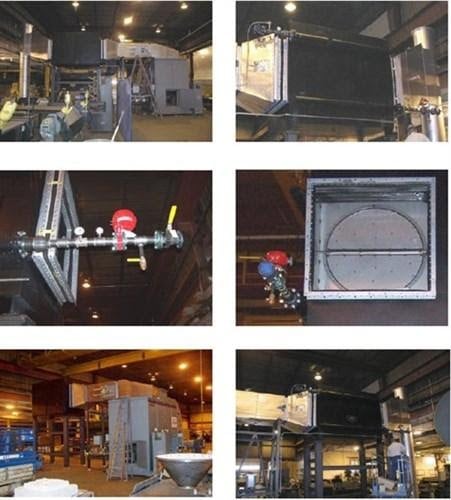Amine Tail Gas Treatment
Comments Off on Amine Tail Gas TreatmentThe discovery of new shale formations throughout the world and the development of new drilling technologies have increased natural gas production and prompted government agencies to instigate tighter air-pollution control regulations on processing operations. Unfortunately, meeting environmental regulations is not a profit-generating endeavor. Simply put, the time and money spent on protecting air, water, and land does not help midstream companies produce more natural gas to ensure the nation’s energy security. As a result, saving money while meeting or exceeding regulations should be on every midstream company’s wish list.
Much like other industries, oil and gas producers are often required by the Environmental Protection Agency (EPA) to obtain a Title V permit, the objective of which is to prevent untreated air pollutants from entering the atmosphere. In addition to their harmful effects on plants and trees, these pollutants, known as volatile organic compounds (VOCs) and hazardous air pollutants (HAPs) are known to cause respiratory ailments, heart conditions, birth defects, nervous system damage, and cancer in humans.
Under the Clean Air Act, most companies with the potential to release more than 10 tons of a single VOC or HAP during a one-year period, or 25 tons of multiple compounds, must install either a pollution-control device or the maximum achievable control technology (MACT). Many of the pollution control devices currently used to abate these emissions also emit significant amounts of carbon dioxide (CO2) and nitrous oxides (NOx). With mandatory greenhouse gas (GHG) reporting on the horizon, processors could soon be paying for the carbon emissions generated by some of these pollution control systems, adding to the capital and operating costs associated with regulatory compliance.
A number of production techniques and processes used by midstream companies are, or soon will be, regulated as emission sources. From stationary combustion engines to amine systems, the industry is facing some fairly strict legislation.
The Challenge
The midstream division of a large, multinational energy corporation was operating several amine systems around the country with tail-gas treatment. A TO at one of these facilities in the western United States had numerous operational problems and extremely high operating costs.
Amine tail-gas treatment is one area of great legislative concern in the industry. Amine systems are a very common and critical component used by natural gas-processing facilities to remove acid gases, CO2, and hydrogen sulfide (H2S) from the wellhead. This is accomplished by running the gas through a column with amine liquid flowing in the opposite direction, stripping acids from natural gas and absorbing them into the liquid. The natural gas is then sent for processing while the amine is sent to be regenerated. The regeneration process removes the acid gases from the amine solution, allowing it to be reused, but the process creates tail gas. This tail gas, and the means for treating it, offer the latest opportunity for the implementation of new technologies and increased profits.
Thermal and catalytic oxidizers are technologies commonly used on a wide variety of applications where VOC, HAP, and odor abatement is required. They destroy harmful emissions through the process of high-temperature combustion. Midstream companies have historically used flares, vapor combustors, direct-fired thermal oxidizers (DFTOs), or recuperative systems for emission destruction. Applications where these devices are applied range from amine tail-gas treatment, nitrogen rejection units, and liquefied natural gas (LNG) processes. The temperature in these systems is maintained somewhere between 1,400°F and 1,800°F so that hydrocarbons are converted to CO2 and water vapor, while the H2S is converted to sulfur dioxides (SO2 and SO3).
When designed properly, these older technologies are fairly dependable, but their effectiveness and efficiency can spark a heated debate. In the case of flares, water is often injected into the device to reduce visible black smoke. This drastically reduces the destruction efficiency-and the EPA is taking note. While TOs and vapor combustors can achieve destruction efficiencies around 99%, they share a common negative aspect with flares: they have a high fuel consumption rate.
Large amounts of fossil fuels are required to bring the air toxins up to proper destruction temperature. Rather than use the heat generated from combustion to preheat incoming pollutants, the energy is simply released into the atmosphere, along with CO as GHGs. Chart A demonstrates just how significant the carbon emissions can be from the various technologies.
All too often, production facilities take the “no news is good news” approach to their air-pollution control equipment when they really should be chasing the benefits of a “company stays green and saves green” approach. A proven, more fuel-efficient abatement technology, called the regenerative thermal oxidizer (RTO), is now being applied to tail-gas treatment where it was once thought impossible.
What differentiates it from other technologies is its ability to use the proper mix of temperature, residence time (or dwell time), turbulence and oxygen to convert pollutants into carbon dioxide and water vapor, while reusing the thermal energy generated to reduce operating costs. In some cases, emission destruction can occur without any additional natural gas or other supplemental fuel.
VOC- and HAP-laden process gas is routed into the inlet manifold of the oxidizer, flow control, or poppet valves, which then directs this gas along with fresh air for combustion into energy-recovery chambers where it is preheated. The process gas and contaminants are progressively heated in the ceramic media beds as they move toward the combustion chamber.
Once oxidized in the combustion chamber, the hot purified acid gas releases thermal energy as it passes through the media bed in the outlet flow direction. The outlet bed is heated and the gas is cooled so that the outlet gas temperature is only slightly higher than the process inlet temperature. Poppet valves alternate the airflow direction into the media beds to maximize energy recovery within the oxidizer.
Thermal energy recovery (TER) within an RTO can reach 97%, reducing, and in some cases eliminating, the auxiliary fuel requirement. Some gas plants have reported over $500,000 in operating cost savings annually. With destruction capability over 99%, the RTO is not only an efficient alternative for this application, but also very effective. However, careful consideration must be given to the design and materials of construction to avoid corrosion, equipment failures, non-compliance and safety issues.
The Solution
The company asked Anguil Environmental Systems, an oxidizer and air-pollution control systems provider, to evaluate various replacement options. The process data provided showed a tail-gas flow rate of about 15,000 pounds per hour (lbs/hr) or about 2,500 standard cubic feet per minute (SCFM) (4012.5 Nm3/hr), a calorific value of 6 Btu/SCF and 25 parts per million by volume (ppmv) of H2S. After evaluating numerous oxidizer technologies, including TOs and thermal recuperative oxidizers, Anguil determined that the best solution would be an RTO.
Having designed oxidizers for similar corrosive applications, the engineers at Anguil recommended that the RTO be built with special materials of construction and design considerations to combat the presence of both carbonic and sulfuric acid.
Carbonic acid is caused by high CO2 levels combined with a saturated process stream. Sulfuric acid is created when H2S is oxidized and the resulting SO3 combines with water vapor present in the RTO exhaust gas. The amine process exhaust at this midstream operation was inert, or lacking oxygen; therefore, fresh air was required for oxidation.
Heat released from combustion of these hydrocarbons can be very high, so fresh air is also added to keep the system from an over-temperature condition. To eliminate condensation of water vapor of the tail gas inside the RTO, this ambient air is preheated to protect metal surfaces from the inorganic acids condensing.
The Result
A unique system utilizing excess heat from the combustion chamber to provide the necessary heat was deployed on this system, further reducing operating costs. The preheat component eliminates the need for additional equipment (gas-fired heater, steam coil) and further minimizes auxiliary fuel consumption. The next step in the corrosion-protection strategy is to implement various stainless-steel alloys on critical components and a corrosion-resistant coating on the inside of the energy-recovery chambers and combustion chamber. The type of stainless steel chosen depends on the presence and concentration of H2S.
The critical components are chosen based on their function within the RTO and their location. These components see exhaust temperatures of up to 600°F, above the limit of corrosion-resistant coatings. The energy recovery chambers and combustion chamber are internally insulated with soft ceramic refractory insulation, limiting the shell temperature (and the maximum temperature to which the coating will be exposed) to 200°F, well below the safe limit of the coating. With the combination of extremely high TER, and the tail-gas calorific value of 6 Btu/SCF, this RTO requires no auxiliary fuel to achieve 99% hydrocarbon and H2S destruction efficiency.
By comparison, a TO or flare designed for the same process gas would consume more than $100 per hour of auxiliary fuel, resulting in an annual fuel cost of more than $750,000. Also, the reduced natural gas consumption results in an additional 2,600 lbs/hr of GHG emissions compared to the RTO.
With the industrial price of natural gas at $6 per thousand cubic feet, and a one-to-one correlation between a cubic foot of natural gas and a cubic foot of CO2 emissions, certified carbon credits could go for about $10 to $30 per metric ton or 1,000 kilograms. This is about 20,000 cubic feet of CO2 on a one-to-one cubic foot to cubic foot basis, then 20,000 cubic feet of natural gas produces one metric ton of CO2.
The credit might be worth $1 per thousand cubic feet of natural gas, or about 15% of the cost, meaning a reduction in natural gas consumption would not only save operating costs but it could, in theory, produce income, assuming a credit can be certified and traded.
Organic Particulate Filtration
Comments Off on Organic Particulate Filtration The Challenge
The Challenge
A food products company that mixes various types of waxes and other components to make the base for chewing gums was faced with the issue of cleaning up a slightly odorous, visible emission being exhausted from two of their process lines. The components of the emission were hot particles of chewing gum and some volatile organic compounds (VOC’s). The particles would quickly clog a conventional filter system or electrostatic precipitator, neither of which could control the odor off the process line. In addition to the emission problem, the condensation of the exhaust stream was damaging the roof of the facility.
The Solution
After thorough technical evaluation, the Self-Cleaning Ceramic Filter (SCCF) was recommended as the ideal solution for processing the exhaust and Anguil Environmental Systems was selected to solve the visual, odor and VOC problem.
The Result
In order to demonstrate to the client that this was a viable solution, Anguil utilized their portable self-cleaning ceramic filter test unit before any purchase decisions were made. During the test, the process lines were run through the ceramic filter in two modes, hot and cold.
First, the system was run in the hot mode with a gas burner firing continuously at 400º-500ºF heating up the process air. The once visible plume disappeared as it passed through the ceramic filter and catalyst module. Second, the ceramic filter was used without heat, and again, the visible plume disappeared as it passed through the ceramic filter and catalyst module. Twenty-four hours of production were run across the ceramic filter without heat and the visible emission was acceptable from a customer and environmental regulation standpoint. However, when utilizing a cold process stream, particulate matter accumulated on the ceramic filter which had to be periodically cleaned by firing the burner. When the cleaning cycle began after the two shifts, a dense white plume was emitted for 90 seconds while the filter element was burned clean. The customer, a food products company, felt that this emission level was not acceptable so they decided the continuous hot running ceramic filter would better fit their needs. It should be noted that for certain operations with visible emissions, the pulse cleaning mode may be acceptable. Many local authorities allow companies to discharge up to five minutes per hour without control.
After the customer determined that the ceramic filter would solve their problems, Anguil proceeded to manufacture and install a 1,000 SCFM (1,577 Nm3/Hr) ceramic filter unit. The unit was used to process the exhaust from two process lines. One of the more significant benefits to the company was Anguil’s ability to reduce the air volume from the processes. Initially, the two gum-based mixers each had a 3,000 SCFM (4,731 Nm3/Hr) high volume, low static pressure fan that was exhausting to atmosphere. Tight covers on the mixers minimized the escape of odor into the mixing room. With the close capture hoods it was possible to reduce the air volume from 6,000 SCFM (9,462 Nm3/Hr) exhaust to 1,000 SCFM (1,577 Nm3/Hr) exhaust from the two process lines. The net air volume reduction of 82% reduced both the capital cost and the operating cost of the system.
In order to guarantee continuous production in the event of a burner failure, Anguil installed a bypass equipped with conventional roughing filters. The exhaust fan was equipped with an inlet vane control to vary the air volume if only one process line was being used. The control panel was outfitted with a user-friendly PLC first out detection system. The entire ceramic filter system was mounted in a light-weight enclosure to allow for roof mounting without significant structural modifications to the building. Growth capacity was accommodated in the gas burner and the fan section, allowing for the addition of future operations. Anguil’s system engineering provided their client with a solution to their compliance needs at reduced air volume and reduced cost.
Meat Processing Odor Control
Comments Off on Meat Processing Odor Control The Challenge
The Challenge
For its first two years of production, a food manufacturer based in South Wales, England, focused its production on potatoes. Neighborhood residents voiced no complaints about odors during this time period. However, as new production lines (including barbequed meats and curried chicken) were added, the complaints began, and it became clear that odor abatement equipment was needed to resolve the issue.
Onsite meetings were held to discuss the issue, concerned citizens and the local environmental health officer attended to discuss the best way to handle the situation. The company employs a large percentage of the local residents, and was concerned about maintaining good community relationships, while at the same time it was in need of a building expansion to introduce a new line of curried chicken products. Planning approval became contingent upon the installation of an odor abatement system to control the new and existing odors.
The two-year old factory had been designed to incorporate emission control equipment, and management was committed to installing the most effective technology available. After a thorough technical evaluation, Anguil Environmental Systems, Inc. was selected and contracted to address the odor emission problem and satisfy the building expansion requirements.
The Solution
Although several odor control technologies were discussed — including masking sprays, wet scrubbing, bio-filtration, carbon absorption and catalytic and thermal oxidation — the Regenerative Thermal Oxidizer (RTO) was the only technology that could guarantee the elimination of 99% of the odorous compounds.
Since future production may produce different odors, it was necessary that the installed technology have the ability to treat a wide range of odorous compounds to a high level of removal/destruction – guaranteed. Although, the guarantee of nearly complete elimination of the odors was the primary concern, capital and running costs were also of utmost importance. The RTO was selected due to its low operating costs and the fact that no waste is produced as a byproduct of its functioning.
 The Result
The Result
Following the installation of the RTO, the results were dramatic, and as promised nearly all of the odors have been eliminated. Due to its well-designed odor control strategy, Anguil resolved the odor emission problem, thereby resolving potential community relations/environmental issues, and meeting its requirements for obtaining planning approval for future expansions.
Bean Roasting
Comments Off on Bean RoastingThe Challenge
After purchasing a new Barth roaster for their East coast processing facility, a nationally known chocolate roaster company knew their emissions and odors would need to be addressed with the increase in production.
Emissions and odors from the bean roasting process have traditionally been treated with an afterburner which simply burns the roaster exhaust with natural gas or other fuel types. This is an effective means of air pollution control but not very economical or energy-efficient. Rising fuels costs and the sustainability concerns prompted this company to find a more energy-efficient, cost-effective means of emission destruction.
The Solution
Recognizing the need for a better solution within the industry, Anguil developed a dependable system that not only accounts for the unique needs of this application but also achieves environmental compliance at a fraction of the operating cost. Expected savings for a four bag roaster can be seen in the illustration below:
| Air Flow Rate | Fuel Cost / Hr | Savings Per Hour | |
| Afterburner | RTO | ||
| 2,500 SCFM (4,012.5 Nm3/hr) | $ 41.30 | $ 4.50 | $ 36.80 |
| 5,000 SCFM (8,025 Nm3/hr) | $ 81.14 | $ 6.71 | $ 74.43 |
| 7,500 SCFM (12,037.5 Nm3/hr) | $ 120.96 | $ 8.91 | $ 112.05 |
| 10,000 SCFM (16,050 Nm3/hr) | $ 160.80 | $ 11.11 | $ 149.69 |
Anguil recommended an 8,000 SCFM (12,840 Nm3/hr) Regenerative Thermal Oxidizer (RTO) to handle the Barth roaster, nip grinder, and alkalizer at this facility.
The Result
With the two-bed RTO, contaminated process gas is preheated as it passes through beds of ceramic media located in the energy recovery chambers. The process gas moves from the pre-heated chamber toward the combustion chamber, where the Volatile Organic Compounds (VOCs) are oxidized, releasing energy into the second energy recovery chamber before going to atmosphere. A diverter valve switches the process gas direction so both energy recovery beds are fully utilized, providing 95% thermal efficiency thereby reducing auxiliary fuel requirements. Under normal operating conditions the unit is self-sustaining, requiring no fuel use to achieve destruction. This energy-efficient design offers significantly lower operating costs in comparison to other emission treatment methods common bean roasting facilities.
Water vapor was a major concern during the design phase of this project and therefore provisions were taken to handle the high moisture airstream coming from the roaster. Not only is water a byproduct of bean roasting but it is also added for flavor and sterilization purposes; if precautions were not taken, it could have caused system components to seize during freezing weather, accelerated corrosion of carbon steel parts, or even oxidizer shutdowns during high production times. Anguil engineers recommended a knock out drum with removal pump just upstream of the RTO. Modifications were also made to the fresh air damper to introduce less water vapor and portions of the ductwork were insulated to prevent freezing.
Special consideration was given to the RTO ceramic media to account for any particulate in the airstream, ensuring proper operation. The oxidizer also has a bake-out feature which works much like the self-cleaning feature on an oven. Organic particulate is regularly burned out during a high temperature cycle, which ensures that the media does not plug, reduces pressure drop, and lowers electrical consumption.
In addition to the emission and odor control equipment, Anguil provided a 7,000 SCFM (11,235 Nm3/hr) Plate Heat Exchanger and corresponding duct work. This sends approximately 1.5 BTU/hr of waste heat from the RTO exhaust stack to a make-up air unit on the roof, saving the company over $80,000 a year in plant heating costs during winter months. On similar applications, Anguil has returned waste heat back to the roasters, which further reduces natural gas consumption and operating costs.
The company has purchased two similar systems from Anguil for facilities in other regions of the United States. The projects have resulted in environmental compliance, lower operating costs, and fewer greenhouse gas emissions for the bean roasting company at all three plants.
Stainless Steel RTOs for Ethanol Emissions and Odors
Comments Off on Stainless Steel RTOs for Ethanol Emissions and Odors The Challenge
The Challenge
A 42 million gallon expansion at an ethanol production plant in the Midwest was certain to put the dry mill out of compliance for emissions such as Hazardous Air Pollutants (HAPs), Volatile Organic Compounds (VOCs), carbon monoxide (CO), nitrogen oxides (NOx), and particulate matter (PM). In general, ethanol production facilities in the United States are permitted to operate under a ‘minor source’ status as long as the total tonnage of key pollutants are below the 100 tons (named sources) or 250 tons (non-named sources) per year limit. However operating restrictions, penalties and fines, as well as community pressures are forcing many plants to strive for the lowest possible emission levels, enabling future capacity expansions.
The Solution
Anguil was awarded a multi-million dollar contract to assist the ethanol plant in meeting Environmental Protection Agency (EPA) regulatory requirements.
The Result
Known for their low operating cost and high destruction rate efficiency, the Anguil Regenerative Thermal Oxidizer (RTO) was selected as the best available control technology for the application. The pollution control device consists of two side-by-side Anguil RTOs handling a process volumetric flow of 120,000 SCFM (Standard Cubic Feet per Minute) (192,600 Nm3/hr). The system will achieve greater than 99% destruction rate efficiency for air pollutants and odorous emissions with 95% thermal energy recovery, ensuring low fuel usage. Portions of the equipment are constructed of 304-stainless steel to protect against corrosion from the ethanol process stream. The project scope consists of equipment design, manufacturing, installation supervision, process integration and start-up.
While several options and suppliers were considered, Anguil was awarded the contract after the Midwest producer evaluated system reliability, capital costs, destruction rate efficiency and operating cost estimates.
Keeping Ethanol Production Green
Comments Off on Keeping Ethanol Production Green The Challenge
The Challenge
In an effort to reduce the world’s dependence on fossil fuels, there has been a major push towards alternatives. Ethanol has been at the forefront of this movement because it reduces greenhouse gas emissions from automobiles and its production has a positive net energy balance. The homegrown fuel also reduces the need for imported oil from sometimes unfriendly and unreliable supplier nations.
Ethanol is produced by fermenting and distilling starch, creating a 200-proof alcohol suitable for combustion in a vehicle. When processing corn, only 70 percent of the kernel is made into ethanol; the remaining fats, proteins, fiber, oils and minerals are referred to as distiller’s grain (DG). If a production plant is not very proximate to dairy operations or other significant livestock feeding needs, it will have to dry the DG in order to prevent spoilage during transport to more distant regional markets. Operating restrictions, penalties and fines, as well as community pressures, are forcing many plants to strive for the lowest possible emission levels from their dryers, enabling future capacity expansions.
Since air permits are granted on a facility-wide basis, when developing, designing and permitting ethanol production facilities, selecting the most appropriate process equipment as well as air pollution control equipment is critical. Some unique DG dryer designs are steam-heated or compressed air-based, but the vast majority of installed dryers are heated with natural gas. Regardless of the dryer type, volatile organic compounds (VOCs), odors and aerosols are emitted from the drying activity. By far the most commonly installed technology for this critical emissions source is some form of efficient thermal oxidation. Most of the major ethanol design firms incorporate thermal oxidation of this exhaust stream into their plant designs, and most state air permitting agencies require it.
 The Solution
The Solution
Process configurations & air permit implications
Selecting a dryer technology and its corresponding pollution control equipment often is the underlying decision for determining air permitting major source status. Prevention of significant deterioration (PSD) thresholds are now 250 tons per year (tpy) per pollutant facility-wide, since the EPA changed its interpretation of PSD rules for ethanol plants, in 72 FR 24060, on May 1, 2007.
In some non-corn-belt areas of the country where ethanol plants are now being proposed, such as those in ozone non-attainment areas or transport regions, major source thresholds are as low as 50 or even 25 tpy of VOCs to trigger non-attainment New Source Review (NNSR) permitting. When combustion emissions from boilers, emergency generators, fire water pump engines and load-out flares are added to those from the dryer and thermal oxidizer, one can envision why these decisions are critical.
NNSR permitting involves determining and installing the lowest achievable emissions rate (LAER), control technology, obtaining emissions offsets, and analysis of alternatives for the entire development project. PSD permitting involves dispersion modeling, best-available control technology (BACT) determination and commitment, and other impact analyses. Both NNSR and PSD permitting involve additional expense and longer permitting timelines, neither of which finds fondness with ethanol developers. Efficient, properly tuned thermal oxidizers are generally considered to meet BACT and LAER requirements, but there is surprisingly little history in the EPA’s RACT/BACT/LAER Clearinghouse database[1], since most ethanol developers to date have sought to avoid NNSR and PSD permitting by maintaining emissions below the threshold levels.
Abatement equipment selection
Some ethanol facilities in the upper Midwest were originally constructed without thermal oxidizers. However, odor complaints and EPA consent orders forced the installation of oxidizers, and hence some form of thermal oxidation is now a part of any new ethanol plant design involving a dryer. Certain plants with solid fuel boilers (often major sources) may vent the dryer exhaust into the boiler for thermal destruction. Others may recover some energy from direct-fired thermal oxidizers by generating steam.
In general, the following two technology solutions have been considered preferred for the ethanol plant DG dryer emission control:
Regenerative thermal oxidizer (RTO):
- Destruction Efficiencies of 98 to 99% for VOCs, hazardous air pollutants (HAPs) and CO
- Designed to handle a wet air stream with some particulate.
- Pre-filters available for higher levels of particulate.
- Thermal energy recovery of 95 percent insures low fuel usage, and low NOX production.
- Fuel injection system further lowers NOX.
Direct-fired thermal oxidizer (DFTO) with waste heat boiler:
- Designed to oxidize 99+ percent of VOCs, HAPS, CO and organic particulate without obstructions, eliminates the potential for plugging.
- Generates steam for use in the process.
- Can reduce overall capital cost of plant and air emissions.
- Optional turbine produces power for driving electric motors or for distribution within the plant.
The Result
A natural gas RTO may have the highest efficiency, the lowest emissions and a lower total installation cost versus other options. A natural gas RTO may allow a larger capacity plant to be constructed (greater than 100 MGY) while remaining a minor source, but most other options will trigger major source permitting. Trade-offs are between capital expenditures and operating expenses, as well as a shorter timeline to construction, versus potential future competitive advantages. A good natural gas supply deal is a must, with some portion of the net input reserved for hedging on the spot market.
An ethanol developer’s speed-to-market, permitting timeline and expenses, material logistics, feedstock, energy source, and selected co-products all relate to the dryer type and air pollution control technology decisions.
Several other parameters need to be considered to evaluate the selection and design of a fully integrated air abatement system, including regulatory requirements and emission characteristics for VOCs, NOX, CO and HAPs. Other parameters include the following process characteristics:
- New or existing plant
- Airflow requiring treatment
- Steam requirements and cost to produce
- Power availability and cost to distribute
Environmental impact
According to the Department of Energy’s Argonne National Laboratory, ethanol-blended fuels reduced CO2-equivalent greenhouse gas emissions by 7.8 million tons in 2005, which had the equivalent effect of removing the annual greenhouse gas emissions of over 1 million automobiles from the road. Many agree that ethanol is a cleaner-burning fuel than gasoline. With state-of-the-art control technology in place at ethanol plants, it can be ensured that production does not counteract the positive impact of this alternative fuel.
- Visit http://cfpub1.epa.gov/RBLC/ to learn more about the RACT/BACT/LAER Clearinghouse.
Waste Heat Generates Steam and Savings
Comments Off on Waste Heat Generates Steam and Savings The Challenge
The Challenge
A coil coating facility purchased a new 15,000 SCFM (24,075 Nm3/hr) Regenerative Thermal Oxidizer (RTO), which had a nominal heat transfer efficiency rate of 90% thermal energy recovery. It was designed with supplemental fuel injection (SFI), which is used during low VOC loading conditions to help save fuel cost. The facility was looking for additional ways to decrease their exhaust air temperature and reduce operating costs.
The Solution
The high exhaust temperature (above 650°F) and large airflow (12,650 SCFM, 20,303 Nm3/hr) in the oxidizer exhaust stack provided the customer an opportunity to add energy recovery measures to further optimize their process and decrease their operating expenses. Because their process required a significant amount of steam, it would likely provide the quickest payback for an energy recovery project.
The Result
Anguil Environmental installed an air-to-steam waste heat recovery boiler to recover exhaust waste heat from the natural gas fired thermal oxidizer and produce 25 psig of steam. The boilers use X-ID tubing for enhanced heat transfer through the helical ribs on the inside of the tubes.
The waste heat boiler package is a skid-mounted unit, with forced circulation, fire tube, and heat recovery steam generator. The unit has automatic, modulating, exhaust gas bypass that is controlled by steam pressure. A boiler feedwater and blowdown separator was included as part of the package.
Installing the waste heat boiler system recovered about 2.58 MM BTU/hr of energy, lowering the stack temperature to 338°F. The addition of the waste heat boiler on this application saved the facility $216,770 per year. The total payback period for this project was less than six (6) months, demonstrating how targeted waste heat recovery can boost efficiency, cut costs, and deliver repaid ROI.
Oxidizer Energy Recovery Options
Comments Off on Oxidizer Energy Recovery Options The Challenge
The Challenge
The mainstream media today is full of allusions to energy awareness and conservation. Just as visible these days are media references to astronomical dollar figures that can boggle the mind. This article does not seek to break out of that mold, but rather to conform to it, as Oxidizer Stack Heat Recovery offers a tremendous opportunity for both energy conservation and energy cost reduction.
The Solution
Consider the following: at any hour of the day there are likely to be more than 10,000 oxidizer systems in service, using a high temperature reaction chamber (with or without catalyst) to treat the exhaust gases from a wide range of industrial processes. The final component of nearly all of these oxidizer systems is an exhaust stack, where the treated exhaust gases are released to the atmosphere at elevated temperatures.
Historically, oxidizer systems have been sized to treat exhaust air flows from 100 SCFM (Standard Cubic Feet per Minute) (160.5 Nm3/hr) up to several hundred thousand SCFM. But conservatively, the average oxidizer system airflow processing capability (i.e. “size”) can be estimated to be between 15,000 and 20,000 SCFM (24,075-32,100 Nm3/hr).
Now, considering these 10,000 stacks emitting hot, treated gases to the atmosphere around the clock; if heat recovery equipment capable of dropping the exhaust stack temperature by 100 ˚F could be installed into each one of them, this would lead to an overall value of over 18 billion BTUs (British Thermal Unit) per hour of energy conservation!
Assuming $10/MM BTU and year round operation – this equates to recovering over $1.5 billion (US Dollars) worth of energy per year!
Taking this into account, it is no surprise that a wide range of stack energy recovery options have been developed and marketed to end-users of oxidizer systems. This article will discuss three important aspects of energy reclamation from hot oxidizer stacks:
- Energy reclamation from oxidizer stacks is one of three potential areas of optimization for oxidizer systems.
- There are distinct challenges that must be addressed in the process of evaluating potential energy savings options.
- There are multiple potential equipment options for this application, each with its own benefits and limitations.
 The Result
The Result
The ABC’s of Oxidizer Stack Energy Recovery
Oxidizer Energy Recovery Options
Using ABC’s in the title of this section is actually a misnomer. Truthfully, the letters A and B should be set aside and the caption should read – The CDE’s of Oxidizer Stack Energy Recovery. The reason for this is twofold:
First of all, any plan for recovering waste heat in the exhaust stack of an oxidizer system is already a Plan C. For anyone taking a hard look at optimizing the energy efficiency of an oxidizer system as a whole, Plan A should consider ‘upstream’ opportunities. For example, retrofits that reduce overall airflow to the oxidizer system and/or increase the concentration of solvents to be treated. Plan B should focus on the internal TER (Thermal Energy Recovery) of the oxidizer system itself. After airflow reduction, maximizing the internal energy recovery of an oxidizer system will almost always lead to the best project payback.
Hence, it follows that energy recovery in the exhaust stack of the oxidizer is Plan C. Now calling it Plan C is by no means meant to downplay the opportunities associated with oxidizer stack energy recovery. The only intent is to fit the concept into the greater framework of energy usage in the oxidizer system as a whole. There are many reasons why Plan A and/or Plan B as defined above may not be attractive or even feasible, making Plan C: Energy Recovery in the Oxidizer Exhaust Stack, the best overall choice for energy conservation efforts.
The second reason that the letters C, D and E are a better fit for the title of this section is that those three letters represent the challenges associated with energy recovery efforts in oxidizer exhaust stacks, namely:
- CAPTURING the energy from the stack itself
- DELIVERING the energy back into the plant cost-effectively
- EMPLOYING the recovered energy effectively inside the plant
Following is a brief discussion of each of these challenges along with the different options for recovering oxidizer stack heat.
Challenge #1: Capturing the Energy
Of the three challenges, the first – Capturing the Energy – is usually the easiest to evaluate and estimate. By simply knowing the airflow and temperature of the exhaust gases in the oxidizer stack, suppliers of energy recovery equipment can quickly begin to model an appropriate device for reclaiming energy effectively. It is often during this first challenge that the overall opportunity for yearly savings is also quantified.
The more information that an oxidizer end-user can provide at this juncture, the more realistic the opportunity analysis can be. At a minimum, those considering stack energy recovery should gather the following before beginning this process:
- Expected airflow and average temperature in the oxidizer stack
- Expected hours of operation per year
- Current energy rates for the plant (gas or oil and electric)
The first two items are often monitored already on a continuous basis in oxidizer data recorders. If that is not the case for a particular system, the most recent EPA (Environmental Protection Agency) stack testing data can be an excellent source for this information.
Two other issues for consideration during this phase of an evaluation are:
Constituents in the exhaust gases (and especially their dew points): Any effort to reclaim energy in the exhaust stack of an oxidizer will lower the oxidizer exhaust gas temperature, bringing with it the potential for condensation of acids. Suppliers of energy recovery equipment will typically take care to ensure that final stack temperature is above any acid dew points. Given the typical solvent laden exhaust from printing presses, this is rarely an issue of concern for oxidizer systems in the flexographic printing industry.
Adding energy recovery equipment to an oxidizer exhaust stack will also come with a system back-pressure penalty. The existing oxidizer fan will usually be tasked with pushing or pulling air through the ‘hot side’ of the added heat recovery component. To keep overall project payback attractive, the goal is usually to choose energy recovery equipment that will limit the added system back-pressure to an amount that the existing oxidizer system fan can handle without major modification. Therefore, knowing the additional capacity available in the oxidizer system fan will help narrow down which cost-effective options for energy recovery are feasible.
Challenge #1 for a typical application may look like this:
Consider a flexographic printer with a ten year old 20,000 SCFM (32,100 Nm3/hr) Regenerative Thermal Oxidizer (RTO). The combined exhaust from all dryers and capture hoods routed to the RTO is 20,000 SCFM (32,100 Nm3/hr) at approximately 150˚F (65.5˚C). The average exhaust temperature from the RTO is 275˚F (135˚C).
Plan C – A 50% effective heat exchanger installed in the oxidizer exhaust stack to transfer the waste heat to air or fluid would drop the stack temperature by approximately 125˚F (51.7˚C) – capturing approximately 2.7 MM BTU/hr. If this energy was 100% useful inside the plant and the plant operated around the clock, this could lead to a yearly savings of up to $225,000.00. A payback of one to two years is certainly possible for a project of this nature.
By comparison:
Plan A – reducing airflow to the RTO by 10% could save approximately 0.3 MM BTU/hr or up to $25,200.00/year. This could likely be accomplished with very little capital investment at all. A payback of less than six months is possible for this option.
Plan B – for the data presented, this RTO is operating with an internal thermal energy recovery (TER) of approximately 92%. Installing additional ceramic heat recovery media to raise the TER to 95% could save approximately 1.0 MM BTU/hr or up to $84,000.00/year. A payback of less than one year is possible for this option.
Challenge #2: Delivering the Energy Back into the Plant Facility Cost Effectively
As seen in Challenge #1, sizing energy recovery equipment and estimating the overall savings opportunity with oxidizer stack energy recovery are not difficult tasks. To take an opportunity analysis and turn it into an actual payback period however, one has to determine the cost of installing the equipment and providing the infrastructure for delivering captured energy back to the plant.
For a cursory analysis, some will take the cost of the energy recovery equipment and double it, calling that the estimated cost of installation. (i.e. Total Estimated Cost = One Part Equipment Cost + Two Parts Installation Cost) This can provide for a quick check of whether a particular idea merits additional investigation. To obtain true payback numbers then a site visit by different tradespeople to estimate the overall cost of energy recovery system installation will be necessary. Fans and/or pumps, control valves, thermocouples, etc. will all need to be both mechanically installed and electrically wired to an existing or new control system. This is often the challenge where the overall project feasibility hangs in the balance.
Challenge #3: Employing the Recovered Energy Effectively inside the Plant Facility
The final challenge is also extremely important for optimizing energy recovery project payback. Ideally, the oxidizer end-user should look for ways in which recovered stack energy can be used in the same process that the oxidizer is connected to. This typically provides the best payback because there are energy demands by that process at nearly all times that oxidizer waste heat is available. In contrast, projects focused on recovering oxidizer exhaust stack energy to help heat a facility, for example, may only be useful for part of the year.
Oxidizer Stack Energy Recovery Options
Oxidizer stack heat has been recovered to perform a wide variety of functions in the plant environment.
Air-to-air heat exchangers have been used to provide pre-warmed fresh air back to process ovens, dryers and/or plant make up air units.
Air-to-fluid heat exchangers have been used to transfer oxidizer stack heat to boiler feed water, plant makeup water, process water, glycol and other thermal fluid loops.
In extreme cases, waste heat boilers have been used with oxidizer stack heat to create steam.
And on the horizon, heat-to-power systems are in development for reclaiming oxidizer stack heat and creating electricity.
One additional option that has been used sparingly is taking hot oxidizer stack air directly back for use in production processes. This is sometimes referred to as Direct Heat Recovery, while the options mentioned above would be termed Indirect Heat Recovery. Direct Heat Recovery from oxidizer stacks is generally shied away from due to the risks of introducing products of incomplete combustion back into a plant environment or the risk of oxidizer “oven dirt” contaminating product, but there are limited cases where this form of oxidizer stack energy recovery has been used effectively.
Each of these options for recovering heat from oxidizer exhaust stacks can be considered within the framework of the three challenges discussed previously.
Air-to-Air Heat Recovery
Probably the most common energy recovery product applied to oxidizer stacks is an air-to-air heat exchanger. Be it a shell-and-tube or plate type heat exchanger, there is a cold side air stream (typically fresh air) and a hot side air stream (typically the oxidizer exhaust) that are used for heat transfer.
Air-to-air heat exchangers have been integral to oxidizers themselves for decades so it is a well-known technology for oxidizer manufacturers to incorporate into an overall system. The programs for sizing air-to-air heat exchangers are quick and easy to use. There are a wide variety of footprints and physical layouts for ease of installation. There are also many low back pressure models that work well with existing oxidizer system fans.
The limiting factor for air-to-air heat recovery in oxidizer exhaust stacks is Challenge #2: Delivering the Energy Back into the Plant Facility Cost Effectively. With air-to-air heat recovery, insulated ductwork is required to transport captured heat back into the facility. Costs for running ductwork in a plant vary widely and can also add up very quickly. The best applications are those with short duct runs for returning heated air.
Air-to-Fluid Heat Recovery
Air-to-fluid heat exchangers are the second most common energy recovery product for oxidizer stacks. As the name implies, heat is transferred from the hot oxidizer exhaust air (again the hot side air stream) to a circulating fluid (the cold side stream). This is typically accomplished by passing the hot air over a coil containing the fluid to be heated. As with air-to-air heat recovery there are a variety of low back pressure designs that can allow installation into an oxidizer exhaust stack without adversely affecting the oxidizer system.
Because piping is less expensive than ducting, air-to-fluid heat recovery has a definite advantage over air-to-air heat recovery when considering Challenge #2: Delivering the Energy Back into the Plant Facility Cost Effectively. However, unless the heated fluid is used directly back in the process that the oxidizer is connected to, Challenge #3: Employing the Recovered Energy Effectively inside the Plant Facility, can be more difficult to address with air-to-fluid heat recovery. Meeting this challenge requires a detailed analysis of the demands for energy in the fluid system versus the availability of waste heat in the oxidizer stack. For example, in some plants the biggest hot water demands come in shutdown situations when the oxidizer is not running.
Air-to-Steam Heat Recovery (Waste Heat Recovery Boilers)
When the solvent laden air sent to an oxidizer system is sufficiently rich, the oxidizer’s internal heat recovery component may need to be partially bypassed or forgone completely. This leads to higher than normal oxidizer stack temperatures and allows for additional options in heat recovery equipment. One such option is a waste heat recovery boiler to recover oxidizer exhaust stack heat and produce steam. Waste heat recovery boilers are custom sized for a particular exhaust gas capacity as well as required steam pressure. A variety of systems are available in vertical, horizontal, single or multi pass configurations. Oxidizers on most applications rarely have the necessary solvent loading and corresponding exhaust stack temperatures to sustain this option.
Heat-to-Power
Sometimes referred to as cogeneration, heat-to-power is an emerging technology that is capable of sending kilowatts directly back into a facility for electrical power. The concept has been implemented on different applications throughout the world but is only now being integrated with combustion devices such as oxidizers. Heat-to-power systems can currently generate up to 100kw per hour from a modest heat source. However, the payback is normally greater than three years, the value most companies use for acceptable capital investment. As electricity costs increase and greater efficiencies are achieved with the technology it will be a very attractive option in the near future. Today, heat-to-power is not necessarily a cost reduction strategy but rather a green initiative that could be used to promote a company as a leader in energy conservation.
Oxidizer stacks represent a significant opportunity for the reclamation of energy. This applies to all oxidizer systems – including both the aging catalytic oxidizers popular in the industry years ago as well as the newer, high efficiency regenerative thermal oxidizers (RTOs) being supplied today. Achieving a cost-effective installation of energy recovery equipment with an attractive payback is not without challenges, but those challenges are being met today in a variety of ways.
Air-to-Water Heat Exchanger Reduces Operating Costs by $120,000 per year
Comments Off on Air-to-Water Heat Exchanger Reduces Operating Costs by $120,000 per yearWhen a leading pharmaceutical manufacturer needed to relocate an oxidizer to a new facility across the United States with different efficiency and energy recovery requirements, Anguil conducted a detailed inspection, provided disassembly and reassembly guidance, and recommended key system modifications. The resulting upgrades optimized performance and delivered substantial energy savings to help the customer meet both their operational and sustainability goals.
The Challenge
This pharmaceutical company had a 5,000 SCFM (8,025 Nm3/hr) oxidizer that they were looking to relocate to another facility across the United States. The destruction rate efficiency and heat recovery expectation at the new location differed from the original design conditions at the current facility.
The Solution
An Anguil field service engineer went to site to inspect the unit. A report detailing the current condition of the oxidizer at its current location was generated as well as a written procedure for the proper dis-assembly and reassembly of the equipment. The service engineer evaluated the unit and made recommendations outlining the modifications necessary to make the unit run at the new facility’s desired destruction efficiency rate and the energy requirements.
The Result
Anguil worked closely with the customer to modify and upgrade the system based on the detailed site inspection report. The work included a control package upgrade and a new hot gas bypass damper.
To address the energy recovery requirements at the new facility, a new economizer was installed between the oxidizer and exhaust stack to transfer heat to water. The exhaust heat from the stack was transferred to the Anguil economizer which in turn created hot water. This otherwise lost energy is captured and can be used in various applications such as boiler feedwater, cold makeup water, process water, glycol, and thermal fluids.
The stainless steel system is a tube and fin style heat exchanger with access doors for inspecting and cleaning of the tubes. The exhaust flow from the catalytic oxidizer is 5,400 SCFM (8,667 Nm3/hr) and the temperature is 450°F (232°C). Roughly 160 GPM of water is heated to 140°F (60°C) with the economizer. The total energy recovered is 1.43 MM BTU/hr or an estimated total savings of $120,512 per year.
A Competitive Advantage
Comments Off on A Competitive AdvantageIn the face of rapid industry advancement, semiconductor chip manufacturers are continually looking for an edge on the competition. Historically, that requires them to stay current with the latest trend in wafer sizes but it can also be achieved through innovative pollution control technologies and techniques at their production plants.
At Anguil, our customers know they can trust our team to develop and deliver quality solutions to their unique environmental challenges. In one case, a large semiconductor chip fabricator wanted to reduce their environmental impact, maintain their productivity, save on operational costs, and conserve valuable floor space. We are experts in environmental efficiency through custom design and manufacturing of air pollution, water treatment, and energy recovery systems.
Project Highlights:
- Client needed an abatement system with over 100,000 SCFM (160,500 Nm3/hr) volume processing capacity and over 98% VOC removal efficiency
- Anguil compiled a system of a rotor concentrator wheel, custom-designed thermal oxidizer with a destruction efficiency rate (DRE) of >99.5%, and a specialized heat exchanger
- Each system was able to meet and exceed the processing capacity and destruction efficiency requested, with the processing capacity double that of the two previous systems combined
The Challenge

The customer approached our team with a request for a new abatement system for their plants. They came to us to stay ahead of their competition by tackling the challenge of reducing their environmental impact without sacrificing their facilities’ productivity and output. While they were currently employing the use of two systems, each with capacities for less than 50,000 SCFM (80,250 Nm3/hr), they were looking for a more efficient and effective solution. Ultimately, they were seeking a system that doubled their SCFM volume processing capacity with a 98% VOC removal level.
Their exact system requirements were as follows:
- >100,000 SCFM (160,500 Nm3/hr) volume processing capacity in a single system with the same footprint as the two existing pollution control devices
- >98% VOC removal efficiency
- No upstream pressure fluctuations
The Solution
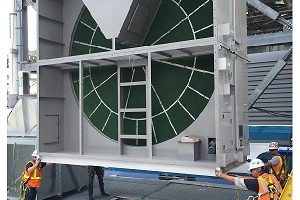
Once fully assembled, all three systems were installed on mezzanine levels of the existing plants. After installation, our technicians completed final commissioning and provided comprehensive operator training. Ultimately, the customer was left with a system that met their needs and a team trained to properly use that equipment.
The Result
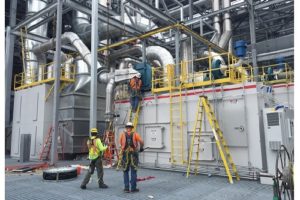
Additionally, by replacing their old air pollution systems with our more effective and efficient system, the customer was able to save on floor space and operational costs.
Learn more about Anguil’s pollution control solutions in this industry.

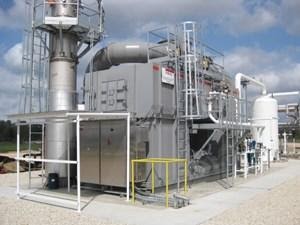
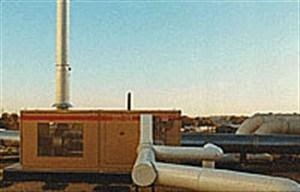 The Challenge
The Challenge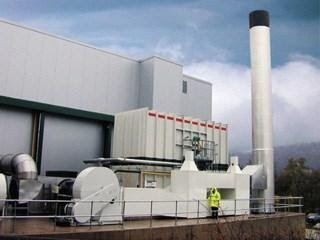 The Challenge
The Challenge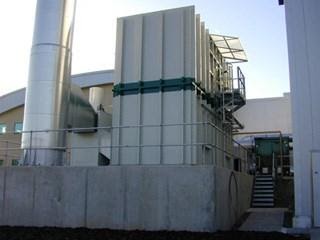 The Result
The Result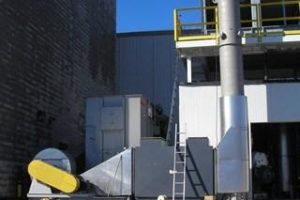
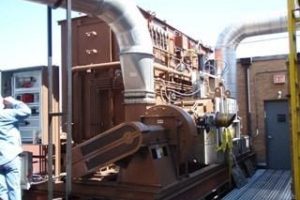
 The Challenge
The Challenge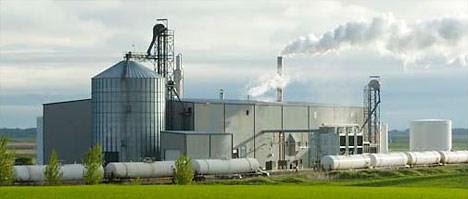 The Challenge
The Challenge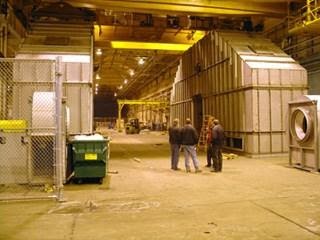 The Solution
The Solution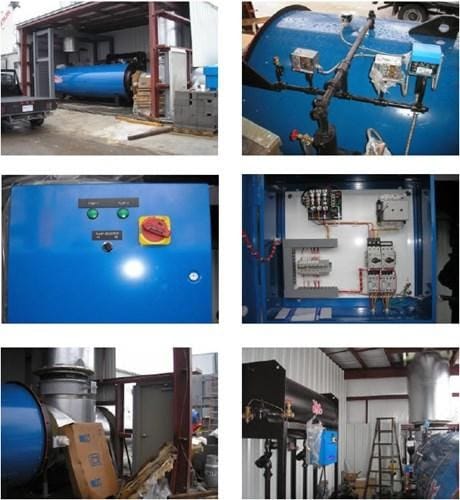 The Challenge
The Challenge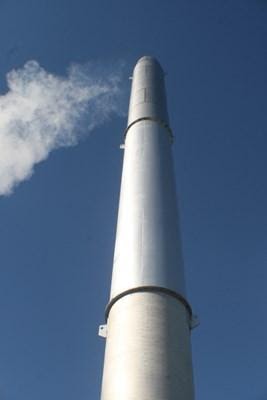 The Challenge
The Challenge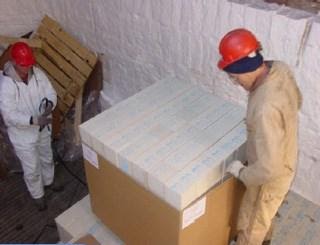 The Result
The Result